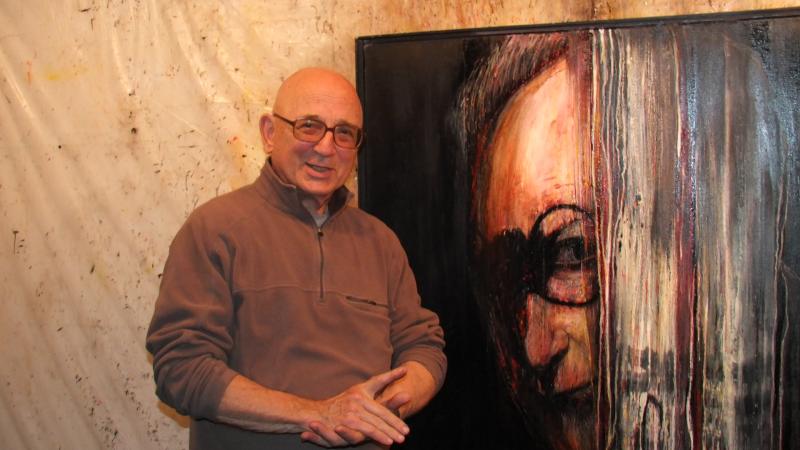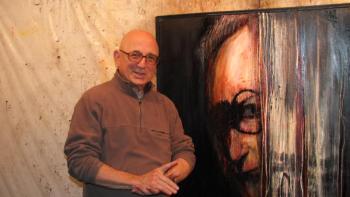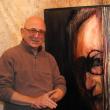Attempting to understand the Holocaust through the arts
“In the capital of a small republic,” poet Lee Sharkey wrote, “Tonight I am walking backwards. If I were blind I would know better than to do this.”
Those who immerse themselves in the works of Maine artists and poets presented in “The Dilemma of Memory” at the Holocaust and Human Rights Center at UMA, will also be walking backwards through time to the years 1933-1945, the 11 years of the Holocaust.
Sharkey's poem cautions that in trying to come to terms with the genocide of six million human beings of Jewish descent from 1933 to 1945, 1.5 million of whom were children, one will get hurt.
This exhibit of paintings, poetry, sculpture, fabric, photography and music was conceived by artist Leonard Meiselman. A former New York City-based artist, Meiselman has lived in Wiscasset full-time for two years. This show is the first venue for his works in Maine.
Meiselman had been introduced to poet Lee Sharkey and approached her to be curator of the art form for the exhibit. Her aforementioned poem is one of his favorites in the show.
“If you are going to involve yourself [in the Holocaust] you will get hurt. You will come out of it with more questions than answers,” Meiselman said. “Going into this material is dangerous. You are walking backwards because you have no choice, the past grips you and haunts you. This show is a wonderful expression of creative, diverse energy focusing on this heritage.”
Known, he said, as a protest painter, Meiselman works in series' and themes. For three years, prior to his relocating to Maine, he found himself painting prayer shawls of Auschwitz. Meiselman doesn't paint images of the Holocaust because he has a familial connection with it. He was, in fact, shocked when the first prayer shawl emerged on his canvas.
“Each painting is like a voyage; you know your departure point, but you cannot anticipate what you will end up with. I was shocked. I was astonished to find a Holocaust image had appeared on my canvas. I was crying, emotionally overwhelmed,” Meiselman said. “The image appeared unbidden on the canvas from a brush in my right hand. Sometimes an artist chooses his subject, and sometimes the subject chooses the artist.”
Meiselman now paints the faces of victims as “an opportunity to rescue them from anonymity.” A sensitive and tormented artist, the expressions of fear, pain, horror, bewilderment and grief confront the viewer. The eyes are said to be the window to the soul. The eyes of Meiselman's victims reflect their profoundly horrific fates.
“Our lives are probably etched in our faces. The human face is a wonderful opportunity for expression and learning. I'm trying to learn. I don't set out to portray horror, terror and fear. I try to imagine and understand what happened — what is still happening.
“Genocide is not historical.”
Sharkey, however, did have family members lost in the Holocaust. She has journeyed to Russia, Ukraine and Lithuania. Although she did visit “killing sites,” her deeper interest was in reclaiming her cultural heritage as it existed before the Holocaust.
“To reclaim and honor those who came before and were examples of deep humaneness in their lives and their work, that seems to me, right now, to be a valuable project,” Sharkey said.
Sharkey invited poets Tony Brinkley, Mark Melnicove, Anna Bat-Chai Wrobel and Martin Steingesser because they had a “long term investment in investigating the Holocaust and its consequences in their work.”
How, asks Sharkey, can we all keep it alive in work, in our perspective of the world? What questions does it lead us to ask?
“What, for each of us, is the way to put the past forward when we are not in direct contact with the witnesses who are almost all gone?”
Meiselman has found camaraderie among fellow artists — photographer Judy Ellis Glickman, Robert Katz, George Mason and Robert Moskowitz.
“It's a generational phenomenon — artists are still coming to terms with what happened,” Meiselman said. “This is very genuine probing stuff by artists going into themselves and their families, and intellects. George Mason's tapestries of his series, 'To Mend' were selected because that is what we must do. We can't let this defeat us. We have to go forward.”
An opening reception for “The Dilemma of Memory,” will be held on Friday, Oct. 17 from 4 to 7 p.m. Each of the poets will read from their works in the show, and a composition by Eliott Schwartz, widower of artist Dorothy Schwartz whose works are included in the show, “Soliloquy for Solo Clarinet,” will be performed by Maria Wagner.
The Holocaust and Human Rights Center is located at 46 University Drive in Augusta.
For more information, visit www.hhrcmaine.org.
Event Date
Address
46 University Drive
Augusta, ME 04330
United States





























